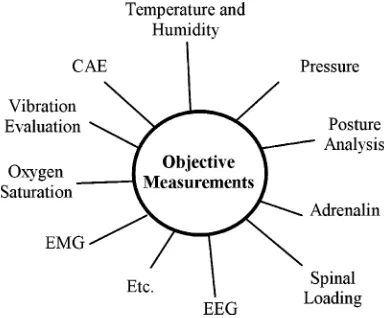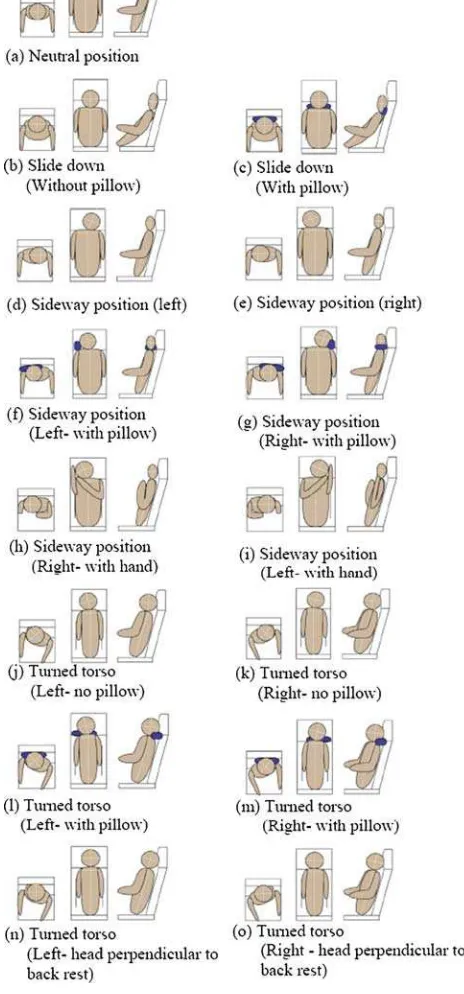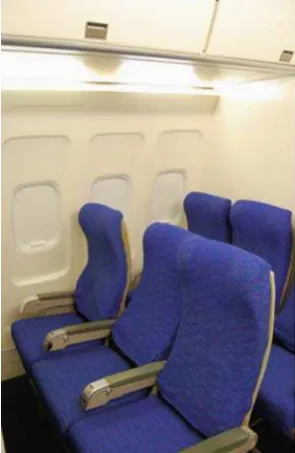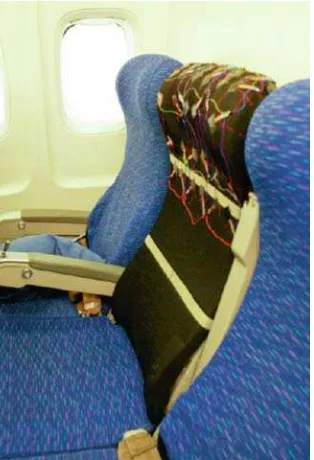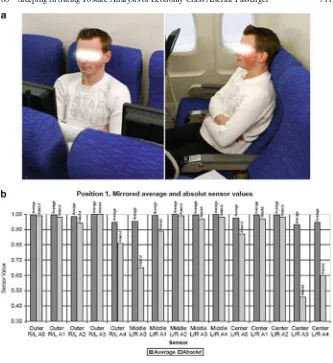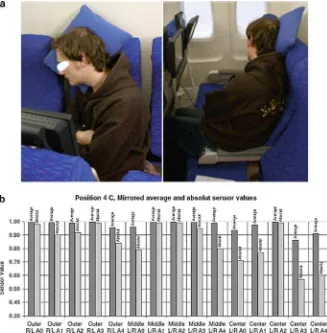Sleeping in Sitting Posture Analysis
of Economy Class Aircraft Passenger
CheeFai Tan, Wei Chen, Floris Kimman, and Matthias Rauterberg
Abstract With the rapid development of technology, the comfort of service has become an important issue. Air travels, especially long distance, may cause both physiological and psychological discomfort to passenger. Passenger comfort is clearly a main factor in user’s acceptance of transportation systems. Sleeping is one of the common activities during the long haul flight. In this paper, subjective and objective measurement method was described to evaluate the sleeping in sitting posture of economy class aircraft seat passenger.
Keywords Aircraft seateconomy classsleeping in sitting posturesubjective methodobjective method
60.1 Introduction
Air travel is becoming increasingly more accessible to people both through the avail-ability of cheap flights and because the airlines are now able to cater for individuals of all ages and disabilities. Health problems may arise due to anxiety and unfa-miliarity with airport departure procedures prior to flying, whilst during the flight, problems may arise as a result of the food served on board, differences in the envi-ronmental conditions inside the cabin (pressure, ventilation, relative humidity, noise and vibration), the risk of cross-infection from fellow passengers, seat position, pos-ture adopted and duration of the flight. These can be further compounded by changes in time zones and meal times, which may continue to affect an individual’s health
C. Tan ()
Technical University Malaysia Melaka, Durian Tunggal, Melaka, Malaysia e-mail:c.f.tan@tue.nl
W. Chen, F. Kimman, and M. Rauterberg
Department of Industrial Design, Technical University Eindhoven, Den Dolech 2, 5612AZ Eindhoven, The Netherlands
e-mail:w.chen@tue.nl;f..p.f.kimman@tue.nl;g.w.m.rauterberg@tue.nl
S.-I. Ao and L. Gelman (eds.),Electronic Engineering and Computing Technology, Lecture Notes in Electrical Engineering 60, DOI 10.1007/978-90-481-8776-8 60,
c
Springer Science+Business Media B.V. 2010
long after arrival at the final destination [1]. Travel by air, especially long distance, is not a natural activity for human. Many people experience some degree of physio-logical and psychophysio-logical discomfort and even stress during flying. Excessive stress may cause passenger to become aggressive, over-reaction, and even endanger the passenger’s health [2,3].
Comfort is an attribute that is highly demanded by today’s passenger. The aircraft passenger comfort depends on different features and the environment during air travel. Seat comfort is a subjective issue because it is the customer who makes the final determination and customer evaluations are based on their opinions having experienced the seat [4]. The aircraft passenger seat has an important role to play in fulfilling the passenger comfort expectations. The seat is one of the important features of the vehicle and is the place where the passenger spends most of time during air travel. The aviation industry is highly competitive and therefore airlines try to maximize the number of seats [5]. Often this results in a very limited amount of seating space for passengers, especially in economy class [6]. In this paper, we described the subjective and objective measurement to analyze the sleeping in sitting posture of economy class aircraft seat passenger.
60.2 Aircraft Seat
Seat is one of the important elements for the passenger comfort. Different seat as-pects have to be seen and taken into account in the comfort model. In charter and economy class the two least satisfactory characteristics are ‘seat comfort’ and ‘leg room’ [1].
The Civil Aviation Authority (CAA) is the regulatory body for the safety guide-lines for aircraft seat spacing. The guideguide-lines are set with safety, not comfort, in mind and relate to robustness of aircraft seats at the time of a crash and the ease of passenger evacuation in the event of an emergency [1]. There are three kinds of seat position in the aircrafts, such as window, aisle and isolated. For passengers seated in the central position of three or more seat row, the feeling of being surrounded is one of the worst aspects of economy air travel.
InNova [7] created a seat design called the bubble. The innovation of the design is to relocate the hand baggage to underneath the seat, therefore eliminating the need for overhead bins; this in turns increase the passenger’s perception of space by reducing the tunnel effect. B/E Aerospace developed the moving set called ICON seating [8]. The moving seat surface allows the passenger to adopt multiple postures, including back and side sleep. Side support wings on the seat bottom can be adjusted to provide leg support in a side sleep posture. ICON seating allows passenger in full control of comfort and personal space.
60.3 Relationship of Subjective Method to Comfort
and Discomfort
Due to the lack of proven analytical metrics, seat manufacturers have opted to rely on subjective evaluations as the main indicator of seat comfort. The seat manufactur-ers developed elaborative subjective evaluation protocols that involved highly struc-ture questionnaires [10]. The questionnaires direct occupants to assign feelings of discomfort to a specific region of seat. The questionnaires, which typically contain numeric scales (e.g. 1D very uncomfortable to 10D very comfortable), produce subjective ratings that are translated into performance requirements/specifications [11]. A properly designed questionnaire is paramount because it affords researchers an instrument from which to establish theories [12].
In the study by Mehta and Tewari [13], ten point scale local discomfort is used to measure the tractor seat comfort. The work is to project the most appropriate method of assessment and selection of tractor seats from engineering and biomechanical view point. Eklund and Corlett [14] used local discomfort with visual analogue scale to study the correlation between trunk and back discomfort. Kyung et al. [15] used a visual body mapping analogue scale as shown in Fig.60.1to obtain overall ratings of comfort and discomfort for the whole body.
60.4 Relationship of Objective Method to Comfort
and Discomfort
Comfort measurement of seat is difficult because of such factors as user subjectiv-ity, occupant anthropometry, seat geometry, and amount of time spent sitting [16]. A great deal of research has been performed in recent years to find objective measures for predicting seat comfort perception. Some of the proposed objective measures include vibration, interface pressure, posture and muscle activity. These objective measures are correlated with subjective data to determine the relative ef-fects of each measure related to comfort [17].
The seat industry strongly encourages research in the field of objective com-fort assessment, especially dedicated to the seat and the related postures [18,19]. The posture is one of the important issues to be considered in the seat design pro-cess [20] regarding not only the car and the user [21,22] but also the experimental conditions. The instruments that used in the posture measurement are camera, op-toelectronic system, driving posture monitoring system, digital signal processing, ultrasonic device, 3D motion analysis, and motion measurement system.
A vast majority of objective measures used for evaluating comfort and discom-fort. From the literature search, the objective measurement methods for seat such as pressure distribution, posture, computer-aided design (CAD), computer-aided engineering (CAE), temperature, humidity, vibration, electromyography (EMG), and adrenaline. Figure60.2shows an overview of different objective measurement methods for seat comfort and discomfort.
60.5 Sleeping Posture Analysis
Two analyses were conducted to study the sleeping in sitting posture of economy class aircraft passenger.
60.5.1 Observation on Sleeping Posture
The main purpose of the observation is to find out the sleeping in sitting posture and sleeping behavior of seated economy class aircraft passenger during long distance travel. The observation was conducted in a long haul flight from Amsterdam, the Netherlands to Kuala Lumpur, Malaysia. The duration of the trip was 12 h. The re-searcher documented the activity of the passengers in his visual range. There were 15 subjects, eight female and seven male selected in the observation. The age of subjects was between 19 and 62 years old. The average age was 28 years old.
Based on the observation results, seven different sleeping positions identified. Observation in a long haul flight established a ground protocol on sleeping behavior of economy class passenger in a sitting position.
The protocol of sitting position while sleeping is based on four general sitting positions and one open sitting position. The sitting position while sleeping protocol as follows (Fig.60.3):
1. Neutral position (a)
2. Slid down on seat in neutral position
With pillow (b)
Without pillow (c)
3. Head in tilted position (left and right)
With pillow (between shoulder and head) (f, g)
Without pillow (d, e)
Supported with hand (between shoulder and head) (h, i)
4. Torso sitting position
With pillow (head in diagonal with backrest) (l, m)
Without pillow (head in diagonal with backrest) (j, k)
Head resting on head rest (head perpendicular with backrest) (n, o)
60.5.2 Objective Analysis on Sitting Posture While Sleeping
The purpose of the objective method is to measure and validate the sleeping in sitting protocol that based on observation method. The objective analysis was conducted in a low cost aircraft cabin simulator (Fig.60.4).
Fig. 60.4 Aircraft cabin simulator
Fig. 60.5 Flowchart of the experimental setup
Fig. 60.6 FSR sensors on head rest area
Twelve participants, four female and eight male, participated in the experiment. The age range of participant was between 22 and 25 years old, with an average of 24 years old. Their average height is 1.82 m.
From the experiment, the sensor outputs corresponded with the sitting posture protocol (Figs.60.7and60.8).
The sitting position with P4C-turned torso, with head facing the seat in front is the most comfortable sitting position for participants. The sitting position with P3C-head tilted with hand supporting between neck and P3C-head are criticized by many participants. For position 5 – freedom for personal sleeping preferences, it is the most preferable sleeping position among the participants. During the experiment, most of participants turned their torso slightly up to perpendicular towards the back-rest as well as leaning to their side of their face (with or without pillow) against the headrest.
60.6 Conclusion
Fig. 60.7 Position 1, neutral sitting position (a) a participant in position 1 (b) sensor output
Fig. 60.8 Position 4C- sitting position in turned torso position with a pillow. (a) A participant in position P4C; (b) sensor output
References
1.Brundrett, G.: Comfort and health in commercial aircraft: a literature review. J. Roy. Soc. Promot. Health121(1), 29–37 (2001)
2.Kalogeropoulos, S.: Sky rage. In: Flight Safety Australia, pp. 36–37 (1998)
3.World Health Organization. Travel by air: health considerations. http://whqlibdoc.who.int/ publications/2005/9241580364 chap2.pdf. Accessed March 2007
4.Runkle, V.A.: Benchmarking seat comfort. SAE Technical Paper, No. 940217 (1994)
5.Quigley, C., Southall, D., Freer, M., Moody, A., Porter, M.: Anthropometric study to update minimum aircraft seating standards. In: EC1270, ICE Ergonomics Ltd (2001)
6.Hinninghofen, H., Enck, P.: Passenger well-being in airplanes. Auton Neurosci 129(1–2), 80–85 (2006)
8.Elliott, C.: One day, that economy ticket may buy you a place to stand. The New York Times(2006)
9.Lantal Textiles. Status May 2008: Lantal’s Pneumatic Cushion Comfort System (2006)
10.Ahmadian, M., Seigler, M., Clapper, D., Sprouse, A.: A comparative analysis of air-inflated and foam seat cushions for truck seats. SAE Technical Paper, no. 2002-01-3108 (2001)
11.Kolich, M., Pielemeier, W.J., Szott, M. L.: A comparison of occupied seat vibration transmis-sibility from two independent facilities. J. Vibrat. Contr.12(2), 189–196 (2006)
12.Scarlett, A.J., Price, J.S., Stayner, R.M.: Whole body vibration: evaluation of emission and exposure levels arising from agricultural tractors. J. Terramech.44, 65–73 (2007)
13.Mehta, C.R., Tewari, V.K.: Seating discomfort for tractor operators- a critical review. Int. J. Indus. Ergonomic.25(6), 661–674 (2000)
14.Eklund, J.A.E., Corlett, E.N.: Evaluation of spinal loads and chair design in seated work tasks. Clin. Biomech.2, 27–33 (1987)
15.Kyung, G., Nussbaum, M.A., Banski-Reeves, K.: Driver sitting comfort and discomfort (part 1): use of subjective ratings in discriminating car seats and correspondence among ratings. Int. J. Indus. Ergonom.38(5–6), 512–525 (2008)
16.Hertzberg, H.T.E.: The human buttocks in sitting: pressures, patterns, and palliatives. SAE Technical Paper, no. 72005 (1972)
17.Kolich, M.: Review: A conceptual framework proposed to formalize the scientific investigation of automobile seat comfort. Appl. Ergonom.39(1), 15–27 (2008)
18.De Looze, M.P., Kuijt Evers L.F.M., Dieen, J.V.: Sitting comfort and discomfort and the rela-tionship with objective measures. Ergonomics46(10), 985–997 (2003)
19.Shen, W., Vertiz, A.: Redefining Seat Comfort. SAE Technical Paper, no. 970597 (1997)
20.Gruber, G.J.: Relationship between whole body vibration and morbidity patterns among in-terstate truck drivers, Southwest Research Institute, pp. 77–167, San Antonio, TX, Center for Disease Control Publication (1976)
21.Transafety Reporter. Truck Survey Highlights Causes of Drowsy Driving and Suggests Pre-ventative Measures, Transafety Incorporated (1998)
![Fig. 60.1 The body mapping for comfort and discomfort rating [15]](https://thumb-ap.123doks.com/thumbv2/123dok/620350.74728/3.439.114.333.310.547/fig-body-mapping-comfort-discomfort-rating.webp)
